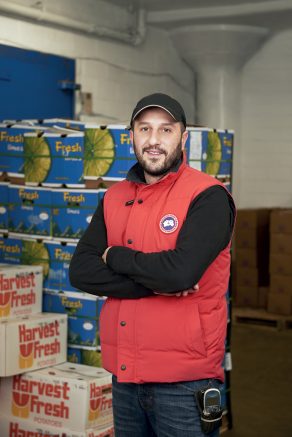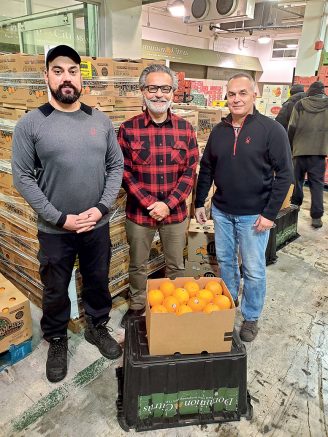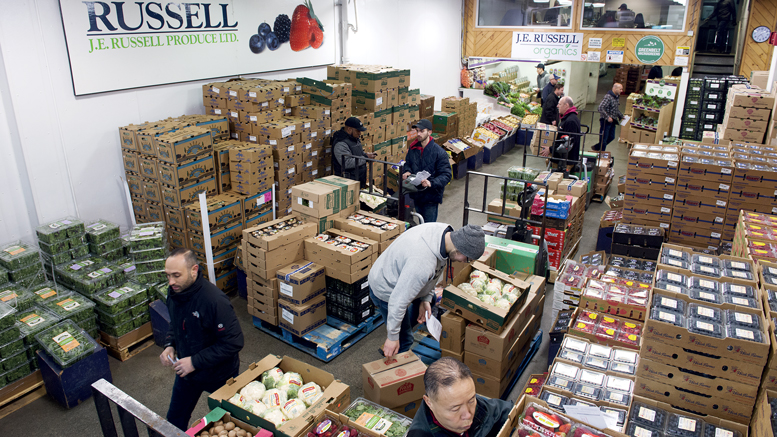Toronto’s Diverse Population Drives Produce Demand
April 6, 2022 | 10 min to read
Toronto's diverse population of over 6.4 million positively influences its food and produce environment, with many ethnic groups exhibiting high consumption rates. Notably, the city boasts a dynamic restaurant sector, with more than 9,000 establishments generating significant revenue. Wholesalers play a crucial role in maintaining quality and freshness, sourcing locally and globally. Despite competition from major chains, independent retailers thrive by focusing on fresh, premium products and adapting to consumer preferences, ensuring a vibrant food scene across the Greater Toronto Area.

Produce offerings, outlets, restaurants and consumption reflect Toronto’s population.
Originally printed in the March 2022 issue of Produce Business.
The multicultural dynamic of Toronto’s large population lends to a favorable food and produce environment.
The Greater Toronto Area (GTA) is home to 6.4 million people, according to Statistics Canada, with more than 51.4% of the population reported as a visible minority, according to City of Toronto statistics.
Hutch Morton, senior vice president at J.E. Russell Produce, describes Toronto as the largest and most multicultural city in Canada. “It has a large mix of urban and suburban neighborhoods and a diverse customer base in both,” he says. “The urban center has a slightly younger demographic than many of the suburbs — reflected in the large number of small, independent retailers who have large produce offerings.”

Toronto’s population makeup affects produce consumption. “The demographic really helps in produce because a lot of ethnic groups have high produce consumption habits,” says Gord Love, vice president of business development with North American Produce Buyers. “The Canadian consumer in general is also a heavy produce consumer.”
The city’s multicultural makeup drives a wide range of produce SKUS, agrees Anthony Greco, owner of Greco’s Fresh Markets with two stores in Toronto. “The consumers here now seem to be very health-conscious and have a palate for fresh premium products.”
Toronto’s produce dynamic is evidenced by its wealth of retail formats, from big chains, to unique independents to discount and convenience stores. “All types of retailers in produce are prospering, just at different velocities,” says Julian Sarraino, chief operating officer at Fresh Taste. “The amount of demand the independents have is impressive.”
Love reports the area’s major chains include Loblaws, Metro, Sobey’s, Walmart and Costco. “These chains have separate banners for specialty,” he says. “For example, Metro has the Adonis banner, Loblaws has Fortinos and Sobey’s has Farm Boy and Longo’s.”
The city also has a thriving ethnic retail scene, reports Ezio Bondi, vice president of Bondi Produce. “There is something for everyone in Toronto.”
VIBRANT FOODSERVICE SECTOR
Toronto also boasts an incredible produce-oriented restaurant sector. In 2019, Restaurants Canada reported there were more than 9,000 restaurants, caterers and drinking places in Toronto, generating more than $7 billion in annual revenues. Sarraino notes the pandemic hurt the foodservice sector, but many have managed to hold on and fight through. “We’re starting to see that business come back as restrictions ease,” he says.
J.E. Russell Produce’s Morton asserts Toronto’s restaurants are represented by a vibrant young group of chefs from around the country and the world. “With the easing of pandemic restrictions and warmer weather coming our way, we are excited to see our foodservice friends get back on the horse and really thrive again,” he says.
THE QUALITY FACTOR
Toronto’s wholesalers allow for produce to move through the system at a higher rate, maintaining a high-end, fresh produce landscape the Ontario terminal is especially known for, explains Greco. “They will always have a major role,” he says.
A major benefit of sourcing from local wholesalers is the fresh component. “We’ll mark our product and it will be at our store four hours later,” Greco says. “No cycling through distribution centers. We’re always able to see and taste the best product for our customers. Vendor relationships play a massive role in negotiating aggressive pricing to compete with big box, as well as staying ahead of the market fluctuations.”
North American Produce Buyers maintains a limited product mix to concentrate on quality. “We focus on stone fruit, grapes and a little citrus,” says Gord Love, vice president of business development. “Our freshness and quality is outstanding.”

Wholesalers also help stores mitigate unforeseen issues. “Obviously, the chains have a lot of direct business, but things come up with interruptions of the supply chain,” says Paul Scarafile, president and chief executive of Dominion Citrus Limited. “We have good programs with strong relationships and they need us to cover shorts.”
DIVERSE, UNIQUE OFFERINGS
Diversity of product is another major benefit. “Toronto’s multicultural aspects mean people from all around the world are looking for different types of product,” says Scarafile. “This leads to diversity in the supply. People aren’t looking for your everyday orange or apple.”
Merchants such as North American offer additional value to customers with products that will differentiate them. “We’re looking to bring to market the best money can buy,” says Love. “Some of the proprietary varieties are pricy, but they’re outstanding. We carry a lot of specialty items within the category. For example, we have lemon plums, sugar plums and sweet pixie plums and we’ve had considerable growth in a new OZblu blueberry variety.”
Stronach & Sons, also located on the Ontario Food Terminal, caters to discriminating independent stores with a higher end product. “This allows the independents to offer a tailored product to fit their customer base,” says Tony Morano, owner.
Bondi’s value proposition includes its ability to source fresh ingredients, from the common to the unique, from around the world. “This is especially true for the restaurants and chefs we work with,” says Bondi.
INDEPENDENT STRENGTH
Although big chains and discount banners may dominate Toronto, many well-run independents are in the landscape, Greco notes. “This has helped the players left differentiate and dominate what they’re good at. Independents certainly look to focus more on fresh, giving them a higher percentage of produce. For that reason, they tend to source better quality produce from the terminal with the advantage of getting it to their stores quicker.”
Independent customers shop wholesalers every day, and they know what they’re looking at and looking for, says Morton of J.E. Russell. “There are different criteria for every customer in their approach to buying and marketing fresh produce, which allows for us to cater to many different types of customers,” he says. “We focus on delivering the highest quality produce, at the right price, in several different categories, enabling us to deliver excellent customer experiences to a wide range.”
Stronach’s Morano notes most independents are customers who physically walk the terminal and have all the information. “They are more hands-on,” he says. “And they can be more discriminating.”
Independents are valuable partners, according to Fresh Taste’s Sarraino. “Many of them have been around for a very long time,” he adds. “They change; they adapt; they continue to offer their customer base exactly what they want.”
Independent retailers also have the advantage of being first to market, explains Love. “It’s not going to be ‘the truck didn’t show up,’” he says. “If they go to get grapes from one wholesaler and they’re out, they go to the next and still get the grapes they want.”
NEW MOVES
To better serve customers, Toronto wholesalers have expanded in several ways. Dominion Citrus acquired Don’s Produce, and John Sanfilippo & Co. last year. “We can service a larger area through these acquisitions,” says Scarafile. “We have been doing business with them for years and it just made sense for us to purchase them. The same families are still running the show at each of those companies. They’re great people and we’re happy they’re a part of our group now.”
Also acquired last year is Stronach & Sons, purchased by foodservice distribution veterans Tony Morano and Joe Scali, who partnered with Vince Bruno from Italian Produce on the deal. “The complete staff has remained onboard, with Danny Simone as manager of the operation,” says Morano. “Danny brings consistency and stability to the business. Everybody in the way of suppliers and customers have remained and we’ve continued to grow since the purchase.”
Additions also come in the form of products. J. E. Russell added chopped salad kits from Taylor Farms to its already strong salad category featuring Fresh Express and Earthbound Farms. “There has been increased demand for all packaged salads over the past two years,” says Morton.

Mike Pirri, buyer and salesman at J. E. Russell, added Top Brass grapes and King River oranges to his growing portfolio of melons and pineapples.
J. E. Russell also experienced moves in its staff. Marco Corbo was promoted to senior vice president of sales and operations. “Marco has been with the company for nearly 30 years and has seen and done just about everything one can do at the company,” says Morton. “He has the leadership skills and personality to guide the team while continuing to ensure that the culture of Russell continues to thrive and shine. Marco is also the lead buyer of the berry category.”
Peter Meschino will be retiring from the business this May after being with J.E. Russell for 45 years. “Peter has been the head of the sales team for over two decades and his deep relationships throughout the market are a testament to the important role that he has played at the company and the deep respect for him,” says Morton.
Bondi Produce recently expanded into dairy and grocery. “This was initially a response to COVID, but it has made us a stronger company as a result,” says Bondi. “Now chefs can buy 60% to 70% of their menu needs from us.”
In March, Bondi is opening a 40,000 square foot, state-of-the art expansion to its existing distribution center. “This will be used strictly for outbound fulfillment,” says Bondi. “We jumped into the project right as COVID started, but we’re glad we kept with it. We’ll be ready for the jump in business as restaurants start to open up and the business gets ramped up again.”
PRODUCE FROM NEAR AND FAR
Although merchants on the market pull from around the globe, they also embrace local offerings. During the Ontario local season, there are over 400 vendors in the farmers market area at the terminal. “That creates a different type of competition here, but also brings in a lot of customers who might also need items not grown locally,” says Morton.
Dominion manages a large local component, and has had a specific local produce company, Scarafile Produce, since 1964. “We sell local fruit, including peaches, plums, apricots, pears, strawberries and blueberries,” says Scarafile. “I like the fact that the food terminal presents local product as well as product from all over the world.”
Fresh Taste’s Sarraino notes close proximity to the growing regions in southern Ontario plays a critical role in terms of being able to showcase product just hours after it’s been picked during the local season.
“Obviously, as we move to imported products for other parts of the year, the proximity changes drastically,” he says. “It then becomes a game of seeing whose product can withstand the transit time the best, and still have a fresh taste to it.”
WHOLESALERS CRITICAL TO PRODUCE SUPPLY
Toronto’s wholesale community consists of wholesalers throughout the Greater Toronto Area (GTA) as well as the Ontario Food Terminal close to downtown Toronto. This wholesale mix represents a crucial cog in the region’s produce supply wheel.
“Wholesalers play a critical role in the food scene for Ontario and Canada,” says Julian Sarraino, chief operating officer at Fresh Taste. “This very competitive marketplace acts as the hub of fresh produce for a massive population. Many independent retailers lean on the market; it’s a critical tool for their supply chain.”
Wholesalers are an essential piece of the supply chain in the GTA, Ontario and truly the entire country, adds Hutch Morton, senior vice president at J.E. Russell Produce. “A chain or a single location, mom and pop store can walk in to buy produce and be treated as equals. That model helps to create and foster the independent retail business.”
The Ontario Food Terminal currently houses 20 warehouse tenants. “That number has been consistent for quite some time now, but what has changed is the number of customers coming to the terminal,” says Morton. “We aren’t quite where we were before the pandemic started, but we are up over this time last year. If we do our job well, we will always be growing the number of customers.”
“The last two years has created a lot of new and innovative companies where produce is a part of their offering. That shift only adds to the opportunities we need to be focusing on and executing for.”
All roads lead back to the food terminal, asserts Ezio Bondi, vice president of Bondi Produce. “It’s the great backbone of the industry here,” he says. “It’s an awesome hub and if you’re an enterprising individual and want to start a retail store, you can really take advantage and develop a procurement strategy here.”
15 of 18 article in Produce Business April 2022

